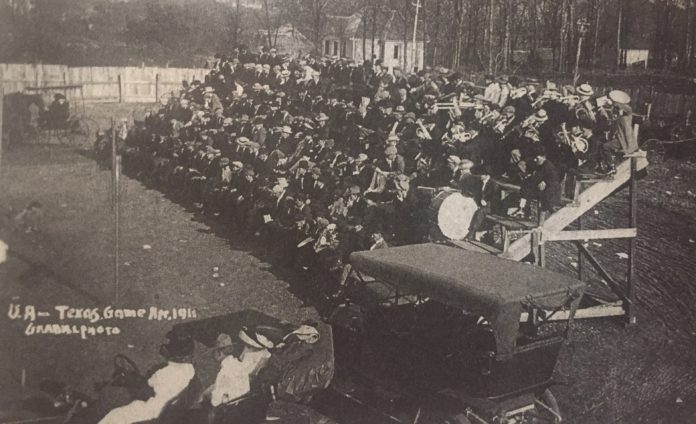Below is Part 2 of a two-part series. Click here for Part 1.
Within days of The X-Ray’s release, Tillman expelled all 36 editors. In response, most of the university’s 724 students quickly signed a petition pledging to attend no classes until the 36 were reinstated. Only seven students attended class the next day, according to Tackett.
Those students’ names aren’t known, but it’s highly improbable more than a few of them would have been football players. Even in an era in which a roster could be around 16 players*, it’s logical to infer most if not all of the football team participated in this strike. Furthermore, we know that Hugo Bezdek**—the head football coach himself—officially endorsed the students’ Progressive agenda. Bezdek, who would ultimately become a college football Hall of Famer after stops at Oregon and Penn Sate, was also the athletic director and baseball coach.
The stalemate between students and administrators lasted almost a week. “There were some tense moments for those who were expelled, who didn’t know whether they were going to have to finish their college careers elsewhere,” Fayetteville historian Charlie Allison told Brady Tackett. “Even those who were struck weren’t what would happen.”
As the week rolled on, the tide of public opinion shifted in the students’ favor. Local Fayetteville merchants, for instance, capitalized on the unrest. Some put up posters displaying their support for the students, Allison said. Local theaters even offered free admission to students during the strike.
On March 2, 1912, only a week after The X-Ray’s publication, Gov. George Donaghey (then chairman of the board of trustees) arrived for a specially convened board meeting with UA faculty and students. There, the student’s representatives argued for the reinstatement for the 36 on the grounds that the The X-Ray’s mission had been to improve the school’s overall quality. Their arguments impressed Donaghey. So the governor decided to repeal the 1905 law and reinstate the 36 students with a promise that faculty would investigate their complaints.
The students, in turn, acquiesced to Donaghey’s request for no celebratory parties or parades. Instead, student-faculty relations were to be quietly mended. Indeed, on March 4, a student representative submitted a formal request for extra class work to make up for time lost in the protests, Tackett wrote.
Although the Mizzou and Arkansas protests differ in so many ways, one strong tie is the amount of stress they caused for their respective university presidents. In 2015, Missouri President Tim Wolfe announced his resignation in the immediate aftermath of the football Tigers’ strike. But back in 1912, before the onslaught of instantaneous news coverage and video, it took a little longer. President Tillman quietly announced his retirement at the 1912 commencement ceremony.
*The 1912 team was 16 players, which was a typically thin roster in the Hugo Bezdek era, according to A Story of Arkansas Football by Orville Henry and Jim Bailey. According to Phil Huntley, who played on the 1909-1911 Razorback teams, the talent and overall team attitude took a dip in 1911 and 1912, a time when the roster had too many “prima donnas.”
Huntley recalled traveling to Austin for a game against the University of Texas in 1911, “a game we should have won.” Instead, Texas won 12-0. “The Texas coach came by afterward and said, “‘You know something, Hugo? Five of your men damn near beat my 11.’ He knew.”
PS: The 1911 opener featured the biggest blowout win in Razorback history: a 100-0 home shellacking of SW Missouri. The 2017 Razorbacks are expected to win their opener against the consistently woeful Florida A&M, too, but don’t expect quite the same margin of victory. It should be greater than the 31.5-point line in the Rice-Stanford opener according to major sportsbooks.
**According to “The X-Ray Incident,” written by Chris Branam, in the Winter 2012 edition of the Washington County Historical Society’s Flashback.



